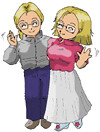
Osamu Tezuka was an insanely prolific manga author. Best known in America for children's series like Astroboy, his work is incredibly diverse. Despite the cute looking characters, a manga like Dororo is strikingly dark and violent.
The story is harrowing enough: a samurai trades 48 body parts from his unborn child to demons in exchange for worldly power. Set adrift like Moses, the new born Hiyaki Maru is little more than a lifeless lump of flesh. Taken in by a kindly old inventor, Hiyaki Maru is given mechanical prosthetics that enable him to survive. More than survive; he trains and becomes a deadly swordsman, determined to hunt down the demons and restore his fragmented body.
Not coincidentally, the story is set in the bloody Warring States period. Like Hiyaki Maru, Japan was a country torn asunder, divided by a succession of warlords, great and petty. The trauma, waste, and horror of war, often a theme for Tezuka, holds sway here as the swordsman and his sidekick, the child thief of the title, Dororo, travel a shattered and broken land.
The art style is strong and dynamic; this is a man at the height of his storytelling power. Reading Tezuka is always like watching a movie, a good movie with a good cinematographer. Swords rip through frames, huge demons twist and distort borders. The manga was influential, and spawned an anime, movie, and excellent video game for the PS2, Blood Will Tell. The third and final volume is due out in August from Vertical Inc, who are to be congratulated for a high quality, oversize presentation.

